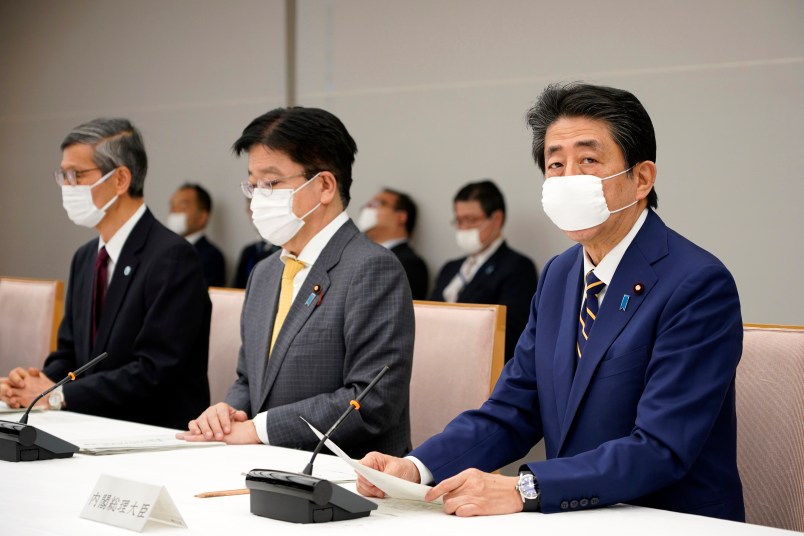TOKYO (AP) — Japanese Prime Minister Shinzo Abe declared a monthlong state of emergency for Tokyo and six other prefectures on Tuesday to ramp up defenses against the spread of the coronavirus as the number of infections surges.
But the move came in the form of a stay-at-home request — not an order — and violators will not be penalized.
The COVID-19 outbreak is now rampant and rapidly spreading, threatening people’s health, their daily lives and the economy, Abe said.
The state of emergency, which is until May 6, will only permit Tokyo Gov. Yuriko Koike and heads of the six other prefectures to do more to reinforce calls for social distancing.
“The most important thing is for each one of us to change our activity,” Abe told a government task force. He urged everyone to cut contacts with others by 70-80% for one month, calling the coronavirus pandemic “the biggest postwar crisis.”
The announcement follows surges in new cases in Tokyo, including consecutive rises exceeding 100 over the weekend. By Tuesday there were 1,196 confirmed cases in the metropolitan region of 14 million people. Nationwide, Japan has reported 91 deaths from COVID-19 and 3,906 confirmed cases, plus another 712 cases and 11 fatalities from a cruise ship that was quarantined earlier at Yokohama port near Tokyo.
Abe has been under pressure to declare a state of emergency to get better compliance with calls for social distancing amid rising alarm over the number of cases without any known contact with other patients.
Tokyo Gov. Yuriko Koike welcomed the emergency measures, saying she expects they “will prevail widely and deeply among the people.” She said her immediate request under the state of emergency is “stay home.”
Japan’s limits on official action during a state of emergency stem from its experience with repression and disasters stemming from fascist governments before and during World War II. The public is doubly wary due to the push by Abe’s ultra-conservative ruling party and its supporters for a constitutional amendment to include a state of emergency clause for disaster and wartime contingencies.
Abe’s government is thought to have delayed declaring a state of emergency out of fear of how it might hurt the economy. But as fear of the pandemic has grown, the public and medical experts have increasingly supported taking more drastic action.
The state of emergency includes a stay-at-home request; guidance to schools on temporary closures and requests to close nonessential businesses and stores and to cancel or postpone events and exhibits. Violators cannot be penalized unless they fail to comply with orders on providing or storing emergency relief goods, such as surgical masks and medical equipment.
Still, the state of emergency could significantly limit movement of people around and out of the city. Takahide Kiuchi, an economist at Nomura Research Institute, said in a recent report that a state of emergency could cause consumer spending to fall nearly 2.5 trillion yen ($23 billion), leading to a 0.4% drop in Japan’s annual GDP.
Abe’s government also announced a 108 trillion yen ($1 trillion) stimulus package to help the country to survive the economic downturn and to protect businesses and jobs.
The government overcame controversy over risks to civil rights to gain approval of a special law last month enabling Abe to declare a state of emergency.
Earlier, Japan sought to curb infections by closely monitoring clusters of cases and keeping them under control, rather than conducting massive testing as was done in neighboring South Korea. That strategy appears to be failing given the sharp rise in cases not linked to previous known infections.
As is true in many places, there are fears over shortages of beds and ICU units for patients with severe symptoms.
___
Follow Mari Yamaguchi on Twitter at https://www.twitter.com/mariyamaguchi







Abe is following/aping his BFF from Mar-a-lago…BUT at least Abe is wearing a mask unlike someone we know who said he will NOT wear mask!
Right now, I’m counting on some kind of inherent empathy on the part of my fellow citizens because it sure as fuck isnt coming form Trump.
Poor Prime Minister Abe… sitting at his Resolute Desk without a single king, queen, prince or dictator beside him. Ditch the mask, man. Your popularity will soar, your Twitter likes will be through the roof, and all the cool world leaders will flock to your side.
And they’ve fucked this up already. A week ago, Aichi Prefecture, where Nagoya is (fourth largest city in Japan), had the second highest number of identified infections. Yet, Aichi and Osaka/Hyogo (second largest contiguous population) are not on the emergency list.
Though this is Japan, a country were even on normal times there is - actually not sure is it social pressure or more like that people could not even consider an alternative, of doing things in way that is considered right and proper. [Stayed there for a year and a bit more, so I think I know at least a little bit of what i am talking about]. Request in Japan may have the same effect that a binding order enforced by fairly plentiful amount of armed troops would have elsewhere.